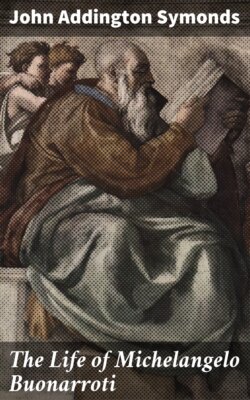Читать книгу The Life of Michelangelo Buonarroti - John Addington Symonds - Страница 31
На сайте Литреса книга снята с продажи.
I
ОглавлениеAmong the many nephews whom Sixtus IV. had raised to eminence, the most distinguished was Giuliano della Rovere, Cardinal of S. Pietro in Vincoli, and Bishop of Ostia. This man possessed a fiery temper, indomitable energy, and the combative instinct which takes delight in fighting for its own sake. Nature intended him for a warrior; and, though circumstances made him chief of the Church, he discharged his duties as a Pontiff in the spirit of a general and a conqueror. When Julius II. was elected in November 1503, it became at once apparent that he intended to complete what his hated predecessors, the Borgias, had begun, by reducing to his sway all the provinces over which the See of Rome had any claims, and creating a central power in Italy. Unlike the Borgias, however, he entertained no plan of raising his own family to sovereignty at the expense of the Papal power. The Della Roveres were to be contented with their Duchy of Urbino, which came to them by inheritance from the Montefeltri. Julius dreamed of Italy for the Italians, united under the hegemony of the Supreme Pontiff, who from Rome extended his spiritual authority and political influence over the whole of Western Europe. It does not enter into the scheme of this book to relate the series of wars and alliances in which this belligerent Pope involved his country, and the final failure of his policy, so far as the liberation of Italy from the barbarians was concerned. Suffice it to say, that at the close of his stormy reign he had reduced the States of the Church to more or less complete obedience, bequeathing to his successors an ecclesiastical kingdom which the enfeebled condition of the peninsula at large enabled them to keep intact.
There was nothing petty or mean in Julius II.; his very faults bore a grandiose and heroic aspect. Turbulent, impatient, inordinate in his ambition, reckless in his choice of means, prolific of immense projects, for which a lifetime would have been too short, he filled the ten years of his pontificate with a din of incoherent deeds and vast schemes half accomplished. Such was the man who called Michelangelo to Rome at the commencement of 1505. Why the sculptor was willing to leave his Cartoon unfinished, and to break his engagement with the Operai del Duomo, remains a mystery. It is said that the illustrious architect, Giuliano da San Gallo, who had worked for Julius while he was cardinal, and was now his principal adviser upon matters of art, suggested to the Pope that Buonarroti could serve him admirably in his ambitious enterprises for the embellishment of the Eternal City. We do not know for certain whether Julius, when he summoned Michelangelo from Florence, had formed the design of engaging him upon a definite piece of work. The first weeks of his residence in Rome are said to have been spent in inactivity, until at last Julius proposed to erect a huge monument of marble for his own tomb.
Thus began the second and longest period of Michelangelo's art-industry. Henceforth he was destined to labour for a series of Popes, following their whims with distracted energies and a lamentable waste of time. The incompleteness which marks so much of his performance was due to the rapid succession of these imperious masters, each in turn careless about the schemes of his predecessor, and bent on using the artist's genius for his own profit. It is true that nowhere but in Rome could Michelangelo have received commissions on so vast a scale. Nevertheless we cannot but regret the fate which drove him to consume years of hampered industry upon what Condivi calls "the tragedy of Julius's tomb," upon quarrying and road-making for Leo X., upon the abortive plans at S. Lorenzo, and upon architectural and engineering works, which were not strictly within his province. At first it seemed as though fortune was about to smile on him. In Julius he found a patron who could understand and appreciate his powers. Between the two men there existed a strong bond of sympathy due to community of temperament. Both aimed at colossal achievements in their respective fields of action. The imagination of both was fired by large and simple rather than luxurious and subtle thoughts. Both were uomini terribili, to use a phrase denoting vigour of character and energy of genius, made formidable by an abrupt, uncompromising spirit. Both worked with what the Italians call fury, with the impetuosity of daemonic natures; and both left the impress of their individuality stamped indelibly upon their age. Julius, in all things grandiose, resolved to signalise his reign by great buildings, great sculpture, great pictorial schemes. There was nothing of the dilettante and collector about him. He wanted creation at a rapid rate and in enormous quantities. To indulge this craving, he gathered round him a band of demigods and Titans, led by Bramante, Raffaello, Michelangelo, and enjoyed the spectacle of a new world of art arising at his bidding through their industry of brain and hand.
